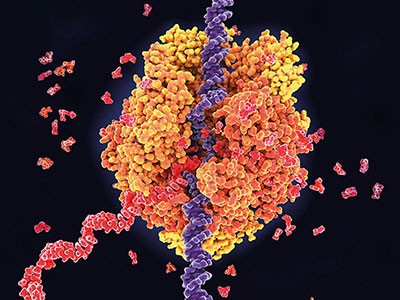
Tools to edit messenger RNA (artist’s illustration) are touted being as safer and more flexible than the CRISPR–Cas9 system, which changes the genome itself.Credit: Christoph Burgstedt/Science Photo Library
RNA editing is gaining momentum. After decades of basic research into how to manipulate this complex molecule, at least three therapies based on RNA editing have either entered clinical trials or received approval to do so. They are the first to reach this milestone.
Proponents of RNA editing have long argued that it could be a safer and more flexible alternative to genome-editing techniques such as CRISPR, but it poses substantial technical problems.
The launch of human trials signals the growing maturity and acceptance of the field, scientists say. “There’s a much greater understanding of RNA technology, and that’s been partially enhanced by the RNA vaccine and the COVID pandemic,” says Andrew Lever, a biologist at the University of Cambridge, UK. “RNA is now seen as a very important therapeutic molecule.”
Temp job
Table of Contents
RNA has a crucial role in protein synthesis: the genetic information encoded in DNA is transcribed into messenger RNA (mRNA) before being translated into proteins. RNA molecules are composed of building blocks called nucleotides, each containing one of four bases, or letters.

RNA therapies explained
RNA-editing techniques aim to compensate for harmful mutations by changing the sequence of RNA, allowing normal proteins to be synthesized. RNA editing can also increase the production of beneficial proteins.
Unlike CRISPR genome editing, RNA editing doesn’t change genes. Nor does it introduce permanent changes, because RNA molecules are transient. This means that the duration of the therapeutic effect could be shorter.
But that transience could offer safety advantages. One risk of CRISPR therapies is off-target effects, or unintended changes outside the target genomic region, notes Joshua Rosenthal, a neurobiologist at the Marine Biological Laboratory in Woods Hole, Massachusetts. “An off-target effect in DNA is potentially quite dangerous. In RNA, it’s less so, because it’s going to turn over.”
One letter at a time
One common RNA-editing approach, single-base editing, harnesses an enzyme that is already found in cells: adenosine deaminase acting on RNA (ADAR). This enzyme swaps a base called adenine in the RNA sequence for a base called an inosine.
Wave Life Sciences in Cambridge, Massachusetts, is exploring single-base editing to treat a genetic disorder called alpha-1 antitrypsin deficiency (AATD), which can damage the lungs and the liver. The disease reduces the production of AAT, a protein made in liver cells that protects lungs from damage caused by inhaling polluted air or other irritants.
Wave’s product is a short chain of nucleotides that directs naturally occurring ADAR enzymes to change a specific letter in each mRNA molecule to correct the mutation that affects AAT production. “By using the cell’s endogenous machinery to edit that single base, you now make a normal protein. And we’ve shown that the normal protein can be expressed at high levels,” says Paul Bolno, Wave’s president and chief executive.
In mice, the drug edited around 50% of the target mRNA in liver cells, which is enough to produce therapeutic effects, Bolno says.
The company’s clinical trial of the drug began last December in the United Kingdom and Australia, and will evaluate the drug’s safety and other features.
Editing whole paragraphs
Another approach, called RNA exon editing, changes thousands of genetic letters in an RNA molecule at once, as opposed to changing just one letter. Exon editing is akin to editing a whole paragraph instead of correcting one typo, says Lever. This technology is particularly important for disorders caused by multiple mutations in a person’s genome; such arrays of mutations are difficult to address with single-base changes, he adds.
The technique targets pre-mRNA, which is transcribed from DNA and then processed to make mRNA. Pre-mRNA includes both exons — parts of the RNA transcript that contain instructions for making proteins — and introns, which don’t contain such instructions. Through a mechanism called RNA splicing, the introns are cut out of the pre-mRNA, and the exons are stitched together to form the final mRNA, which is translated into protein.

Collect more data from Africa to improve gene therapy
Companies such as Ascidian Therapeutics in Boston, Massachusetts, are leveraging the RNA-splicing process to remove mutation-containing exons and replace them with healthy ones. Last month, Ascidian received approval from the US Food and Drug Administration for a clinical trial of an exon editor to treat Stargardt disease, which causes vision loss. People with the disease have several mutations in a single gene, leading to the production of a defective protein that normally protects the retina.
Ascidian’s therapy relies on an engineered DNA segment that is delivered into cells and produces normal RNA exons. These replace the mutated ones during the splicing process, resulting in functional proteins. The DNA also produces RNA sequences that facilitate exon editing.
“With one molecule, [the therapy] is able to replace 22 exons at one time,” says biologist Robert Bell, head of research at Ascidian.
Cancer-quashing RNA
The potential of RNA-based therapies is not limited to genetic diseases. Rznomics, a biopharmaceutical company in Seongnam, South Korea, is testing an RNA editor to treat hepatocellular carcinoma, the most common type of liver cancer. In September 2022, the company started a clinical trial in South Korea, which it intends to expand internationally.
Rznomics’s approach involves mRNA splicing — but, unlike Ascidian’s method, it doesn’t use the cell’s own splicing machinery. Instead, the company co-opted a naturally occurring ribozyme, an RNA molecule that can induce splicing in target regions of mRNA. Researchers engineered the ribozymes to cut open mRNAs in tumour cells and insert a lethal cargo: an RNA sequence that is translated into a protein that generates a toxin that induces cell death. When surrounding cancer cells come into contact with these cells, the toxin spreads, promoting their death as well. This therapeutic molecule replaces an RNA sequence that is associated with tumour growth.
The use of the splicing approach against more than one disease is very exciting, says Lever, who is also the chief medical officer of Spliceor in Cambridge, UK, a firm that is working on RNA-splicing therapies. “It opens up a whole new range of possibilities of treatment for things which otherwise can’t be treated.”
